Genre: Strategy Developer: Micronet Publisher: Micronet Players: 1-2 Released: 1992
Sequels are a funny thing. Sometimes, an acclaimed game never gets a sequel despite popular and critical demand. Other times, a game no one seemed to care about suddenly reappears in the marketplace, now with a Roman numeral “II” attached to its name. Either way, it’s tough to imagine that anyone was eagerly awaiting a sequel to Warrior of Rome, a disastrously ill-conceived real-time strategy game which made scarcely a ripple in the Genesis market (and which I’ve previously reviewed). Even so, here we have Warrior of Rome II, released by Micronet in 1992. As another RTS featuring Julius Caesar as its protagonist (the Japanese release title is Ambition of Caesar II), it seems fated to follow in the footsteps of its failed predecessor.
So is Warrior of Rome II a fresh start for the series? Or, to paraphrase Ned Flanders, is it Micronet’s answer to a question no one asked?
Once you’ve gotten past the comically over-sized, scrolling Micronet logo with which the game greets you, Warrior of Rome II offers you two gameplay options: a map select mode, in which you can pick one of the game’s 20 maps and take on the computer or a friend and campaign mode, in which you follow in the footsteps of Julius Caesar through a series of 16 different battlefields. The first game’s plot revolved around the rescue of Cleopatra, but this time Caesar is sent away by the Roman Senate to suppress a rebellion in Asia. Battle by battle, he gradually works his way homeward, taking on foes in modern-day Turkey, Cyprus, Greece, and other foreign lands before reaching the Italian peninsula. Meanwhile, his adversary Pompeius is scheming against him, and a showdown awaits in Rome itself.
Nearly every aspect of Warrior of Rome II has been revised and improved over the original, and it wouldn’t surprise me if the entire game had been rewritten from scratch. The graphics have been completely overhauled, and the flat landscape and simplistic, tile-based sprites of its predecessor have been replaced by an isometric perspective and mobile, animated characters (with a rather chibi look).
The soundtrack of the first game was weak and sometimes even out-of-tune, but Warrior of Rome II has an appropriately epic, martial score. Eight or nine main melodies loop during the stages, including two tunes that emerge when one side or the other is close to defeat, and another dozen or more play during cut scenes or are triggered by specific gameplay events. I wouldn’t rank it among my favorite soundtracks on the Genesis, but it’s certainly effective and even memorable. All of the game’s 24 music tracks can also be accessed via the sound test option, which pairs each melody with dancing soldiers who sashay across the screen in Busby Berkeley-esque geometric patterns.
Warrior of Rome II uses a primitive window-based menu system, similar to those seen in early multitasking OSes. The game’s commands and info boxes are divided between seven (!) different windows, and things can easily get cluttered, but players can customize the size, shape, and placement of any window. The screen still feels crowded, but I was able to find a window setup that worked for me. Warrior of Rome II also comes with a thick manual that – unlike the first game’s mistake-filled mess – is helpful, thorough, and humorously earnest (witness the glossary at the back of the manual, which offers lengthy definitions of words like “windows” and “save”).
Warrior of Rome was password-based, but also had a RAM disk that allowed you to save and reload at any time as long as the console stayed on. Warrior of Rome II takes this a step further, with two battery-backed memory slots to save your progress, and the exact state of every parameter seems to be recorded (including window size and placement). Every time I resumed a saved game I felt that I was picking up exactly where I’d left off, down to the smallest detail — and in a game this complex, that’s impressive.
Unlike its predecessor, which was strictly linear, Warrior of Rome II permits the player some freedom of action. Caesar’s path towards home splits in several places, and whether you send him on a southern route through Cyprus and Crete, or northward through central Turkey, is up to you. Unfortunately, the game renders this freedom meaningless by forcing you to backtrack and beat the scenarios you’ve missed before unlocking the final battle in Rome. That’s a shame, since having multiple, independent paths would’ve tightened things up and added replay value.
Every battle in Warrior of Rome II has the same goal: to annihilate the enemy armies and their fortresses. Like most RTS games, you give orders to your units, and they semi-autonomously carry those orders out in real time. Each battle is completely self-contained, so both Caesar’s army (in red) and his opponents (in blue) take the field with weak, inexperienced recruits. However, in campaign mode, the computer usually starts with a larger army, more territory, and more fortifications (sometimes many more).
All units start out as blank slates and acquire skills simply by taking action. Units that engage in combat, and survive, emerge with improved fighting skills, and once they’ve had a chance to recuperate, longer life bars. Units that help to build a structure are able to build it faster next time, and even just moving around the map gradually increases a unit’s mobility. This system works quite well and flows very naturally, with no “grinding” necessary.
The default sprite is a generic infantryman, but units change in appearance to reflect their newly-acquired skills. For example, a unit that gains enough mobility will suddenly become a mounted unit. Units also turn bright red when they’ve taken over 50% damage, which is a clear sign of trouble or a good reason to chase down a retreating enemy, since if he escapes and recuperates, he’ll come back stronger than before. However, caution is required when telling your troops to pursue a fleeing foe, as an unattended unit will happily chase its opponent deep into enemy territory, where it’s liable to be surrounded and slaughtered.
If a unit is annihilated, it turns into an angel and floats offscreen in a manner reminiscent of the Twinbee series on NES. Assuming you have enough population in reserve (see below), you can create a new one to take its place, but all of the old unit’s accumulated skills will have been lost. Consequently, it’s crucial to safeguard your experienced soldiers, and it can easily be a net loss to kill five newly-formed enemy units but lose one of your elite units.
Three types of buildings can be built: fortresses, coliseums, and shipyards. Fortresses are the most important, since they’re the only place you can form a new unit (up to a total of 20) or heal an existing unit, and destroying all enemy fortresses is a requirement for victory. Once you build a new fortress, a little town will gradually spring up around it, and the town’s buildings represent the available population. Fortresses grow over time and can eventually host quite a few armies at once, but they depend on the surrounding village to maintain them. Creating a new unit, or recruiting new soldiers to replace casualties, makes some of the little buildings disappear, and if too many disappear, the fortress will shrink. (You can also attack the villages around your enemy’s fortresses to encourage shrinkage, and this becomes a key tactic later in the game.)
Coliseums are described as training facilities, but these small, easy-to-build fortifications are more often used to guard a bridge or provide temporary refuge for a wounded unit on its way home. Shipyards churn out ships (naturally), which any unit can board and use to cross bodies of water or engage in naval combat.
You can have up to 10 of each structure, which is more than enough until you reach the last few scenarios. If necessary, you can instantly demolish any of your buildings, allowing you to build a new one somewhere else. Destroying an enemy building is a much lengthier process, taking anywhere from 10 seconds (for a peasant’s house) to five minutes or more (for a full-sized fortress). A unit stationed inside a structure will fire projectiles (or what the manual calls “indirect attacks”) at any nearby enemy units.
Combat in Warrior of Rome II tends to heavily favor the defender, and strongly encourages wolfpack tactics. Even an extremely weak unit, with only a handful of soldiers left, can successfully defend a fortress or coliseum by inflicting heavy damage with projectiles. And even the most battle-hardened unit will suffer terrible losses if it comes under attack from multiple enemies at once, so if several inexperienced or depleted units band together, they can often hold bridge crossings and other narrow passes by surrounding the key entry square on three sides.
One way around this is to use ships, which can travel up coasts and rivers to bombard entrenched foes with fiery projectile attacks. Since a ship can anchor just offshore and still keep its targets within projectile range, the only sure way to counterattack is with a ship of one’s own. However, the game’s naval battles are confusing and chaotic, and generally I found it better to avoid them whenever possible.
Most of the time, progress is made through a repeated cycle of cautiously extending your forces, building at the edge of your territory, tempting the enemy into a premature attack against your fortifications, and then launching an all-out counterattack against the depleted foe. When this process succeeds, you might capture a vital bridge crossing, entrap and destroy a powerful enemy army, or if you’re very lucky, raze a hostile fortress and build one of your own in its place. But at the beginning of each scenario, even small gains will be hard-fought, and the enemy is constantly looking for opportunities to break through your defenses and attack your home base. In later campaigns, when your army starts out drastically overmatched and outnumbered, it’s no easy task to hold the line.
At first the pace of battle is glacial, even if you turn up the game speed to maximum. It’s difficult to tell how much of this is due to your units’ lack of skills and mobility, and how much is due to the Genesis CPU getting overloaded. As you approach the end of each battle, however, the pace gradually accelerates, and by the time the game starts playing one side’s “danger” music, everything is moving pretty quickly.
The box art for Warrior of Rome II claims to offer “hundreds of hours of game play.” One could hardly be blamed for feeling skeptical, since Genesis games have seen a lot of hyperbole when it comes to playtime. (The early RPG Sword of Vermilion famously promised “over 300 hours of nonstop gameplay,” but in reality only took about 20 hours to complete.)
But if Warrior of Rome II is exaggerating, it’s not by much; this game is very, very long. Campaign mode alone took me over 80 hours to beat, and I’d like to think I was fairly efficient in my playthrough. I don’t know whether this makes Warrior of Rome II the lengthiest game in the Genesis library (in terms of pure gameplay time required), but it’s certainly up there.
If you throw in another 20-30 hours for two-player contests and playing through the additional maps that aren’t used in campaign mode, you’re looking at a good 100 hours of gameplay. And to be clear, you can’t play Warrior of Rome II on autopilot; success in the game depends on constantly monitoring every parameter of your troops’ actions, tweaking them to respond to slight changes in your opponent’s behavior or formation, and making sure they don’t get annihilated on some wild goose chase deep into hostile territory.
How you feel about that prospect depends, naturally, on whether you’re engaged by Warrior of Rome II‘s basic mechanics. When I first started playing, the game seemed to amount to little more than a simplistic process of baiting, surrounding, and destroying the enemy armies one by one until my own armies were strong enough to attack their home fortress.
Somewhere around the midpoint of campaign mode, though, the difficulty and complexity of the scenarios sharply increased. The landscape began to have a dramatic effect on the course of battle, and the early placement of fortifications became crucial: too close to home, and they can’t function as effective springboards for aggression; too far, and they’re very difficult to defend. Small decisions had enormous consequences whose nature could take half an hour of gameplay, or more, to become apparent. All told, the game began to look less like a middling misfire, and more like a diamond in the rough.
There’s no question that Warrior of Rome II is a formidable time sink. Some of the later battles can literally take up all your waking hours in a day, or more. The game is also challenging and, in my experience, rather addictive. What’s less clear to me is how fun it really is, especially in proportion to the commitment demanded by campaign mode. Sometimes it felt engaging and interesting, but in the latter stages of the game I started to feel like I was trapped in Groundhog Day. (In fairness, I had visions of battery failure robbing me of 60+ hours of work, so I ended up overdosing on the game by racing through the last half-dozen battles. That’s not the game’s fault, and it wouldn’t have been an issue in 1992.) I should also note that I haven’t tried the two-player mode. Elsewhere on the Internet, several people have written warm reminiscences of pouring hours into teenage battles with friends or siblings, so the game may well shine as a two-player contest.
I’m not sure whether Warrior of Rome II will be of interest to most modern gamers, who are spoiled for choice in the RTS genre and may not see much reason to endure the game’s slow pace and inordinate length. But within the context of the Genesis library, I don’t know of any other title that offers gameplay quite like it. It’s not without its flaws – and it’s certainly not for all tastes – but unlike its predecessor, I think Warrior of Rome II actually achieves its goals as a game and is basically a successful effort. At last, the “ambition of Caesar” has a worthy representative on the Genesis.
SCORE: 8 out of 10

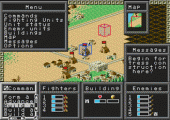
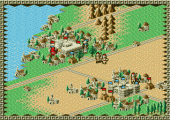
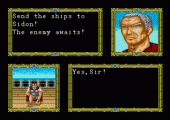
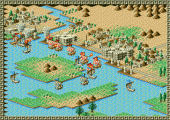
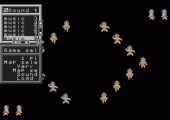
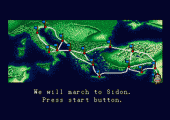
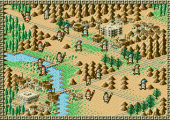
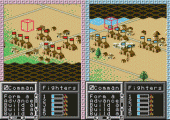
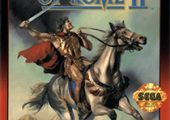
Recent Comments